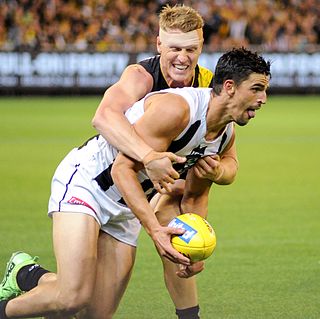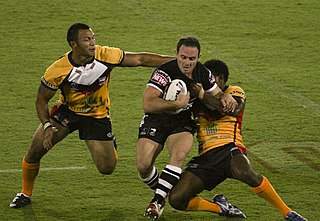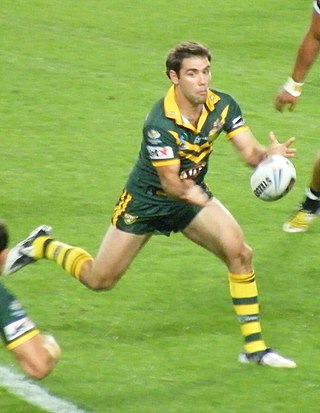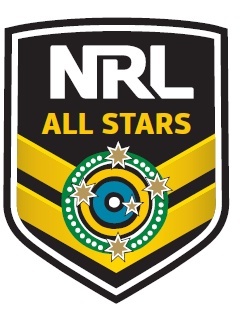Related Research Articles

Most forms of football have a move known as a tackle. The primary purposes of tackling are to dispossess an opponent of the ball, to stop the player from gaining ground towards goal or to stop them from carrying out what they intend.

Rugby league football, commonly known as just rugby league and sometimes football, footy, rugby or league, is a full-contact sport played by two teams of thirteen players on a rectangular field measuring 68 metres wide and 112–122 metres long with H shaped posts at both ends. It is one of the two codes of rugby football, the other being rugby union. It originated in 1895 in Huddersfield, Yorkshire as the result of a split from the Rugby Football Union over the issue of payments to players. The rules of the game governed by the new Northern Rugby Football Union progressively changed from those of the RFU with the specific aim of producing a faster and more entertaining game to appeal to spectators, on whose income the new organisation and its members depended. Due to its high-velocity contact, cardio-based endurance and minimal use of body protection, rugby league is widely regarded as the toughest and most brutal collision sport in the world.

A try is a way of scoring points in rugby union and rugby league football. A try is scored by grounding the ball in the opposition's in-goal area. Rugby union and league differ slightly in defining "grounding the ball" and the "in-goal" area. In rugby union a try is worth 5 points, in rugby league a try is worth 4 points.
In rugby football, the penalty is the main disciplinary sanction available to the referee to penalise players who commit deliberate infringements. The team who did not commit the infringement are given possession of the ball and may either kick it towards touch, attempt a place kick at goal, or tap the ball with their foot and run it. It is also sometimes used as shorthand for penalty goal.

Tag rugby, or flag rugby, is a non-contact team game in which each player wears a belt that has two velcro tags attached to it, or shorts with velcro patches. The mode of play is based on rugby league with many similarities to touch football, although tag rugby is often deemed a closer simulation of full contact rugby league than touch. Attacking players attempt to dodge, evade and pass a rugby ball while defenders attempt to prevent them scoring by "tagging" – pulling a velcro attached tag from the ball carrier, rather than a full contact tackle. Tag rugby is used in development and training by both rugby league and rugby union communities.

Touch rugby refers to games derived from rugby football in which players do not tackle each other but instead touch their opponents using their hands on any part of the body, clothing, or the ball.

Like most forms of modern football, rugby league football is played outdoors on a rectangular grass field with goals at each end that are to be attacked and defended by two opposing teams. The rules of rugby league have changed significantly over the decades since rugby football split into the league and union codes. This article details the modern form of the game and how it is generally played today, however rules do vary slightly between specific competitions.

Recreational Football was a non-contact version of the Australian rules football game first played in 2003 and later sanctioned by the Australian Football League's game development arm, it was inspired heavily by the growing popularity of tag rugby. It was a more accessible version of Australian rules football that people could pick up and play. It was a mixed competition, with eight players on each team, accessible to players of both sexes, all shapes and sizes and requires minimal equipment to play. Rec Footy was criticised mainly by Australian rules players for appearing similar to netball and being too restrictive, lacking of ability for skilled footballers to run kick and play naturally whilst also penalising newer unskilled players with frequent turnovers.

A comparison of American football and rugby union is possible because of the games' shared origins, despite their dissimilarities.
A comparison between American football and rugby league is possible because of their shared origins and similar game concepts. Rugby league is arguably the most similar sport to American football after Canadian football: both sports involve the concept of a limited number of downs/tackles and scoring touchdowns/tries takes clear precedence over goal-kicking.

The team sports rugby union and rugby league have shared origins and thus many similarities.
The experimental law variations (ELVs) were a proposed set of amendments to the laws of rugby union. They were proposed by the sport's governing body, the International Rugby Board (IRB), and trialled games at Stellenbosch University in 2006. In 2008 thirteen of the 23 variations trialled were played globally including; greater responsibility for assistant referees, corner posts no longer considered to touch in-goal, no gain in ground if the ball is moved into the 22-metre line by a player from the same team as the kicker, quick throw ins can travel backwards, no restrictions to players in the lineout, restrictions on where receivers and opposition hookers can stand in a lineout, pregripping and lifting allowed, mauls can be pulled down and players can enter with their head and shoulders lower than their hips, offside line is five metres away from the scrum for the backs and scrum half must be positioned close to the scrum, all offences apart from foul play and offsides are a free kick, and unplayable rucks and mauls are restarted with a free kick. In 2009 the IRB approved ten of the laws, rejecting the laws relating to mauls, numbers in a lineout and the increase in sanctions punishable by free kicks.

Rugby union is a contact sport that consists of two teams of fifteen players. The objective is to obtain more points than the opposition through scoring tries or kicking goals over eighty minutes of playing time. The play is started with one team drop-kicking the ball from the halfway line towards the opposition. The rugby ball can be moved up the field by either carrying it or kicking it. However, when passing the ball it can only be thrown laterally or backward. The opposition can stop players moving up the field by tackling them. Only players carrying the ball can be tackled and once a tackle is completed the opposition can compete for the ball. Play continues until a try is scored, the ball crosses the side line or dead-ball line, or an infringement occurs. After a team scores points, the non-scoring team restarts the game at the halfway with a drop kick toward the opposition. The team with the most points at the end wins the game.
Rugby union is a team sport played between two teams of fifteen players.
This list of rugby league terms is a general glossary of the terminology used in the sport of rugby league football. The sport has accrued a considerable amount of jargon to describe aspects of the game. Many terms originate from the Laws of the Game. A number of aspects of the game have more than one term that refers to them. Different terms have become popularly used to describe an aspect of the game in different places with notable differences between the northern and southern hemispheres.
A penalty in rugby union is the main disciplinary sanction available to the referee to penalise a team who commit deliberate infringements. The team who did not commit the infringement are given possession of the ball and they may either kick it towards touch, attempt a place kick at goal, or tap the ball with their foot and run. It is also sometimes used as shorthand for penalty goal.
A comparison of Canadian football and rugby union is possible because of the games' shared origins, despite their dissimilarities.
In rugby league football, the Laws of the Game are the rules governing how the sport is played. The Laws are the responsibility of the Rugby League International Federation, and cover the play, officiating, equipment and procedures of the game.

The Rugby League All Stars Match of the National Rugby League is an annual rugby league football match between the specially-formed Indigenous All Stars and an All Stars team, both of whose members are made available for selection public vote. The game has been played since 2010 at a variety of venues across Australia. The player judged man-of-the-match is awarded the Preston Campbell Medal, named after indigenous Gold Coast player, Preston Campbell. Between 2010 and 2015, the Indigenous All Stars opponent was an NRL All Stars team, they were replaced for 2016 by a World All Stars team.

The laws of Rugby Union are defined by World Rugby and dictate how the game should be played. They are enforced by a referee, generally with the help of two assistant referees.
References
- 1 2 "International League Tag Laws" (PDF).
- ↑ "Weissel Cup – Sullivan Cup – LeagueTag Premiers – Group 9 Rugby League Inc – SportsTG". SportsTG. Retrieved 16 April 2018.
- ↑ "Group 9 Junior Rugby League".
- ↑ "MEDIA RELEASE: CRL Announces Positive Participation Results – Country Rugby League of New South Wales" . Retrieved 16 April 2018.